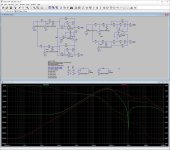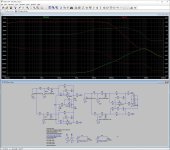So why don’t you add a third circuit with an OPA1632 and have a direct compare between the three.
Hans
Hans
I normally match all passives in differential circuits to 1% or less. Although no matching needed with 0.1% resistors.probably even 1% is totally unrealistic and should be higher.
I'm aware that measurements are now out of fashion in this thread but I've noticed that "stock" filter has somewhat elevated distortion at 10kHz.
This is stock filter (without 3rd stage).
View attachment 1278463
Did you measure both channels and if so, did they behave similarly?
The version Hans measured had NE5532 op-amps in the second (and third) stages. Did you use NE5532 or OPA1678?
OPA1678The version Hans measured had NE5532 op-amps in the second (and third) stages. Did you use NE5532 or OPA1678?
Ji
So he obviously favoured the Signal + CM.
When you want to compare both circuits you have to use Out and Out2, because with the second circuit the SE output is made from the differential input, so when just looking at SE outputs you can’t compare them.
Hans
This is exacly what Mark did in SE with all CM content still available in the signal.Slowing down the CM loop supposedly improved sound by helping to retrieve more detail. This is what happens to CMRR.
So he obviously favoured the Signal + CM.
When you want to compare both circuits you have to use Out and Out2, because with the second circuit the SE output is made from the differential input, so when just looking at SE outputs you can’t compare them.
Hans
Please translate this into engineer talk ;-)helping to retrieve more detail.
//
Now you are definitely on to something. Increasing one cap to 8n4 and CMRRs are similar so Marcel's CM loop has clear edge against tolerances.
Not really; component tolerances cause the exact same error because both feedback configurations are exactly the same. The only difference is the implementation of the active part, which doesn't dominate anyway.
Looking at SE output was to see the CMRR of both circuits. Looking at differential output the impact of e.g. one cap being 8n4 is about the same in both circuits so the servo does little to help with that.When you want to compare both circuits you have to use Out and Out2, because with the second circuit the SE output is made from the differential input, so when just looking at SE outputs you can’t compare them.
One thing that stands out in these simulations is that the divider at CM servo opamp output has an impact on CMRR. Stock filter with 3k9/680 divider does not seem to be optimal. But that does not explain why differential output is impacted.
With worsened CMRR who knows where the retrieved detail comes from 😉Please translate this into engineer talk ;-)
I just tried OPA992 as CM servo opamp. It has slew rate of 32V/us but GBW of only 10.6MHz so it is not "faster" but has slew boost. Almost identical result at 10kHz as OPA210 so no change for the better.The OPA1632 that you used has a GBW of 40Mhz and a slew rate of 72V/usec versus 18Mhz and only 6.4V/usec for the OPA2210, so you are seemingly comparing different topologies with unequal op-amps.
As already mentioned, in Marcel’s circuit DM and CM are treated separately.
So when forcing both Firdacs to produce the same output, CMRR can be tuned to compensate for tolerance differences with one of the two 2K resistors without affecting the DM gain.
Hans
So when forcing both Firdacs to produce the same output, CMRR can be tuned to compensate for tolerance differences with one of the two 2K resistors without affecting the DM gain.
Hans
It were the two signal processing opamps in the first stage like the OPA1632 that I was referring to, not the CM servo.I just tried OPA992 as CM servo opamp. It has slew rate of 32V/us but GBW of only 10.6MHz so it is not "faster" but has slew boost. Almost identical result at 10kHz as OPA210 so no change for the better.
Hans
Earlier I've tried OPA1612 in place of OPA2210. That has 27V/us slew rate and 40MHz GBW. Differential distortion was a bit worse than with OPA2210. So it seems this is not about opamp speed.It were the two signal processing opamps in the first stage like the OPA1632 that I was referring to, not the CM servo.
- Home
- Source & Line
- Digital Line Level
- Return-to-zero shift register FIRDAC

